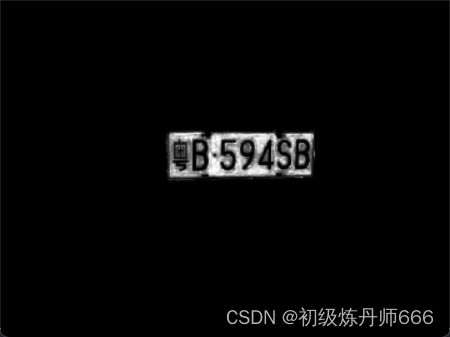基于SVM的车牌识别算法
基于SVM的车牌识别系统(Python代码实现)
车牌识别系统是智能交通系统的重要组成部分,有着广泛的应用。车牌识别系统主要有车牌定位、字符分割和字符识别三部分组成,本文的研究重点是车牌字符识别这部分,本文提出了一种基于OpenCV和SVM的车牌识别方法。首先通过Soble边缘检测算法与形态学算法相结合来确定大致的车牌轮廓,结合车牌的外接矩形的面积与长宽比来筛选出符合车牌特征的候选区域,然后使用投影法将车牌中的字符分割出来,最后使用SVM分类器来对分割出的字符进行识别,输出识别结果。经过验证,该车牌识别系统能够适用于比较复杂的环境,识别准确率相对较高。为了提升该系统的可操作性,本文使用PyQt5设计了GUI界面,提升了系统的可操作性,同时使界面更加美观。
一、算法流程
一个完整的车牌号识别系统要完成从图像采集到字符识别输出,过程相当复杂,基本可以分成硬件部分跟软件部分,硬件部分包括系统触发、图像采集,软件部分包括图像预处理、车牌定位、字符分割、字符识别四大部分,一个车牌识别系统的基本结构如图:
二、图像预处理
获取蓝色和绿色通道:
hsv = cv2.cvtColor(src, cv2.COLOR_BGR2HSV) # 将RGB图像转换为HSV图像
h, s, v = cv2.split(hsv) # 分离H,S,V
lower = np.array([100, 90, 40])
upper = np.array([124, 255, 255]) # 设置阈值
mask = cv2.inRange(hsv, lower, upper) # 获取图像蒙版
img = cv2.bitwise_and(s, s, mask=mask) # 在图像蒙版上使用“按位与”运算符吗,分离绿色和蓝色通道
直方图均衡化:
img = cv2.equalizeHist(img) # 直方图均衡化,增强对比度:将已知灰度概率密度分布的图像经过变换,使其称为一个均匀灰度概率密度分布的新图像
img = cv2.GaussianBlur(img, (3, 3), 0, 0, cv2.BORDER_DEFAULT) # 高斯滤波
flipped = cv2.flip(img, 1) # 图像翻转,1:水平翻转
sobel1 = cv2.Sobel(img, cv2.CV_8U, 1, 0, ksize=3) # 图像边缘检测,Sobel算子,对x轴方向求导
sobel2 = cv2.flip(cv2.Sobel(flipped, cv2.CV_8U, 1, 0, ksize=3), 1) # 先平滑图像边缘,再翻转
img = sobel1 / 2 + sobel2 / 2
img = img.astype('uint8') # 强制类型转换
th = (np.mean(img) + (np.max(img) - np.mean(img)) * 0.6)
ret, img = cv2.threshold(img, th, 255, cv2.THRESH_BINARY) # 简单阈值函数,从灰度图像中获取二进制图像
img = close_op(img, 36)
三、车牌定位
for contour in contours:
area = cv2.contourArea(contour) # 计算图像轮廓面积
if area < 200 or area > 50000: # 判断车牌轮廓区域
continue
rect = cv2.minAreaRect(contour) # 求出点集contour的最小矩形面积,返回值rec[0]为矩形的中心点,rec[1]为矩形的长和宽,rec[2]矩形的旋转角度
if rect[1][0] * rect[1][1] < 666 or area < rect[1][0] * rect[1][1] * 0.6:
continue
dy, dx = contour.flatten().reshape(contour.shape[0], -1).T.ptp(1)
cwb = rect[1][1] / rect[1][0] if rect[1][1] > rect[1][0] else rect[1][0] / rect[1][1]
if dy < dx or cwb < 2.5 or cwb > 6:
continue
if not check_plate(src, rect):
continue
plate = extract_plate(src, rect) # src为原始图像,rect为车牌区域坐标
四、车牌字符分割
def plate_cut_text(img):
'''
车牌字符分割,将分割好的车牌区域进行字符分割
'''
sum = np.sum(img, 1)
limit = np.mean(sum) * 0.2
bound = []
start = 0
for i in range(len(sum) - 1):
if sum[i] < limit and sum[i + 1] >= limit:
start = i
elif sum[i] >= limit and sum[i + 1] < limit:
bound.append([start, i])
start = 0
if start != 0:
bound.append([start, len(sum - 1)])
up, down = 0, 0
for b in bound:
if b[1] - b[0] > down - up:
up = b[0]
down = b[1]
return img[up: down + 1, :]
五、基于SVM的车牌字符识别
reader = SVM_ocr.Reader()
def plate_recognition(plate): #字符识别代码
'''
车牌识别核心代码,使用SVM对分割的车牌字符进行识别,并将识别结果返回
'''
img = cv2.cvtColor(plate, cv2.COLOR_BGR2GRAY)
th = (np.mean(img) + (np.max(img) - np.mean(img)) * 0.2)
_, img = cv2.threshold(img, th, 255, cv2.THRESH_BINARY) #阈值函数
img = plate_cut_text(img)
display('plate th', img, 360)
bound = plate_split(img) #调用plate_split函数,对车牌字符进行拆分,返回一个列表,列表每个值记录车牌每个字符起始位置
print('拆分出来的各个字符起始位置:',bound)
plate_res = []
for i, b in enumerate(bound):
display('character_'+str(i), img[:,b[0]:b[1]], 50)
if b[1] - b[0] > 5 and b[1] - b[0] < 28: #判断每个分割出来的字符宽度是否正常
if len(plate_res) == 0:
ch = reader.recognize_chinese(adjust_vision(img[:, b[0]:b[1]+1]))[0] #识别车牌汉字
else:
ch = reader.recognize_alnum(adjust_vision(img[:, b[0]:b[1]+1]))[0] #识别车牌字符
plate_res.append(ch) #将识别结果添加到变量ch中
return plate_res #返回车牌识别结果







